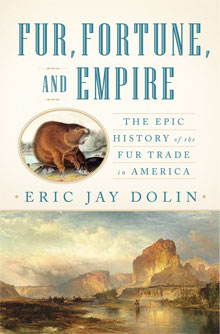Eric Jay Dolin, PhD ‘95, admits that before he began work on Fur, Fortune, and Empire, he knew little about the fur trade. “What I did know was essentially limited to the mountain-men era,” he says. But Dolin became curious about the subject after reading James Truslow Adams’s The Founding of New England a few years ago. In that book, which won the 1922 Pulitzer Prize for history, Adams asserted that the Bible and the beaver were the two mainstays of the Plymouth Colony in its early years. “Given that the Pilgrims were Puritan separatists who went to America to escape religious persecution, I understood Adams’s reference to the Bible,” Dolin says. “But I had no idea why he had thrown beavers into the mix.”

By Eric Jay Dolin, PhD ’95
W. W. Norton, 2010, $29.95
Intrigued, Dolin hit the library. He learned that for more than a decade after their arrival in America, the Pilgrims made most of their money through the sale of beaver pelts, which they shipped to London. “Within a couple of days, I experienced that exhilarating feeling that comes when you find a great book topic,” he recalls. “What really excited me was that I realized I could use the history of the fur trade as a narrative backbone to tell a broader and equally fascinating story about how America evolved from a loose collection of colonies into a transcontinental nation.”
Recounting the history of the fur trade gave Dolin an opportunity to research characters such as Thomas Morton, who set up a community in what’s now Quincy, MA, where he traded guns with the Indians and threw wild parties; the multimillionaire John Jacob Astor, whose attempt to expand his fur-trading empire to the Pacific coast ultimately failed in a dramatic fashion; and Marie Dorion, an Iowa Indian and the only female to take part in the cross-country expedition Astor sponsored, who with her two young sons survived for months in the winter wilderness after her husband and the rest of their trapping party were attacked by Indians.
Don’t settle for half the story.
Get paywall-free access to technology news for the here and now.